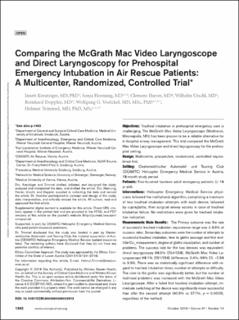| dc.identifier.citation | Kreutziger, J., Hornung, S., Harrer, C., Urschl, W., Doppler, R., Voelckel, W. G., & Trimmel, H. (2019). Comparing the McGrath MAC video laryngoscope and direct laryngoscopy for prehospital emergency intubation in air rescue patients: a multicenter, randomized, controlled trial. Critical care medicine, 47(10), 1362. | en_US |
| dc.description.abstract | Objectives:
Tracheal intubation in prehospital emergency care is challenging. The McGrath Mac Video Laryngoscope (Medtronic, Minneapolis, MN) has been proven to be a reliable alternative for in-hospital airway management. This trial compared the McGrath Mac Video Laryngoscope and direct laryngoscopy for the prehospital setting.
Design:
Multicenter, prospective, randomized, controlled equivalence trial.
Setting:
Oesterreichischer Automobil- und Touring Club (OEAMTC) Helicopter Emergency Medical Service in Austria, 18-month study period.
Patients:
Five-hundred fourteen adult emergency patients (≥ 18 yr old).
Interventions:
Helicopter Emergency Medical Service physicians followed the institutional algorithm, comprising a maximum of two tracheal intubation attempts with each device, followed by supraglottic, then surgical airway access in case of tracheal intubation failure. No restrictions were given for tracheal intubation indication.
Measurements Main Results:
The Primary outcome was the rate of successful tracheal intubation; equivalence range was ± 6.5% of success rates. Secondary outcomes were the number of attempts to successful tracheal intubation, time to glottis passage and first end-tidal Co2 measurement, degree of glottis visualization, and number of problems. The success rate for the two devices was equivalent: direct laryngoscopy 98.5% (254/258), McGrath Mac Video Laryngoscope 98.1% (251/256) (difference, 0.4%; 99% CI, –2.58 to 3.39). There was no statistically significant difference with regard to tracheal intubation times, number of attempts or difficulty. The view to the glottis was significantly better, but the number of technical problems was increased with the McGrath Mac Video Laryngoscope. After a failed first tracheal intubation attempt, immediate switching of the device was significantly more successful than after the second attempt (90.5% vs 57.1%; p = 0.0003), regardless of the method.
Conclusions:
Both devices are equivalently well suited for use in prehospital emergency tracheal intubation of adult patients. Switching the device following a failed first tracheal intubation attempt was more successful than a second attempt with the same device.
Tracheal intubation (TI) remains the golden, but challenging and rare (2–12%) standard of care for securing the airway and ensuring appropriate ventilation in the prehospital emergency setting (1–4). Lacking routine (even < 12 intubations per physician and year) and the specific prehospital setting (5–7) may contribute to difficult TIs, with the literature documenting up to 50% as being impossible (8–10).
Consequently, identification of devices that may facilitate TI appears to be of utmost importance. Presently, video laryngoscopes (VLs) are considered to be effective alternatives to direct laryngoscopes (DLs) when a difficult airway is presumed (11,12). Yet, in-hospital findings, even in the emergency department (13), as well as manikin studies (14,15) obviously may not be transferred to the prehospital setting. The few available randomized controlled trials (RCTs) evaluating VL there (16–18) failed to prove superiority or at least equality to DL. Nevertheless, VL have become part of standard Emergency Medical Service (EMS) equipment (19–21). The Austrian Air Rescue provider OEAMTC (Austrian Automobile, Motorcycle and Touring Club) implemented the McGrath Mac VL (McGrathVL; Medtronic, Minneapolis, MN) for prehospital airway management in its Helicopter EMS (HEMS) program in 2015. This offered the opportunity to compare the McGrathVL and the DL for prehospital TI in the skilled hands of the OEAMTC HEMS crews. The hypothesis of this multicenter, RCT was that both the McGrathVL and the DL (Medicon, Tuttlingen, Germany) have equivalent success rates for TI in the prehospital emergency environment. Primary outcome was the TI success rate for each device. Secondary outcome variables were the total number of TI attempts, time until passage of the tracheal tube through the glottis and to first end-tidal Co2 as a surrogate variable for successful TI. Additionally, the median category of visualization of the glottis, the median category of HEMS physician’s subjective assessment of TI performance, technical difficulties, and any harm during TI were documented. | en_US |

